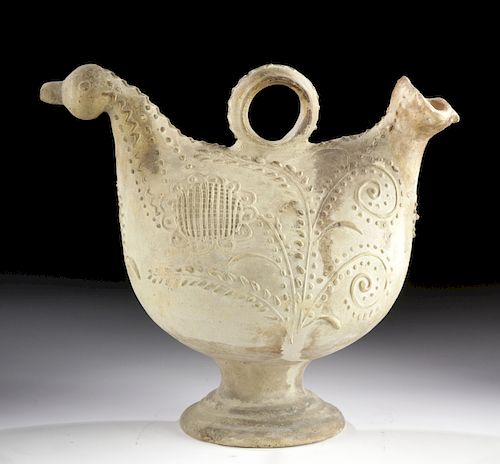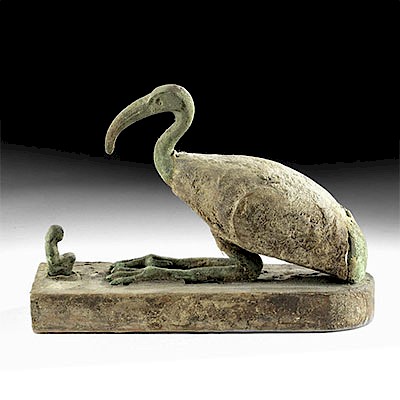Published Umayyad Ceramic Bird Vessel w/ Floral Motifs
Lot 117
About Seller
Artemis Gallery
686 S Taylor Ave, Ste 106
Louisville, CO 80027
United States
Selling antiquities, ancient and ethnographic art online since 1993, Artemis Gallery specializes in Classical Antiquities (Egyptian, Greek, Roman, Near Eastern), Asian, Pre-Columbian, African / Tribal / Oceanographic art. Our extensive inventory includes pottery, stone, metal, wood, glass and textil...Read more
Estimate:
$2,000 - $3,000
Absentee vs Live bid
Two ways to bid:
- Leave a max absentee bid and the platform will bid on your behalf up to your maximum bid during the live auction.
- Bid live during the auction and your bids will be submitted real-time to the auctioneer.
Bid Increments
| Price | Bid Increment |
|---|---|
| $0 | $25 |
| $300 | $50 |
| $1,000 | $100 |
| $2,000 | $250 |
| $5,000 | $500 |
| $10,000 | $1,000 |
| $20,000 | $2,500 |
| $50,000 | $5,000 |
| $100,000 | $10,000 |
| $200,000 | $20,000 |
About Auction
By Artemis Gallery
Oct 31, 2019
Set Reminder
2019-10-31 10:00:00
2019-10-31 10:00:00
America/New_York
Bidsquare
Bidsquare : Fine Antiquities, Asian, Ethnographic Art
https://www.bidsquare.com/auctions/artemis-gallery/fine-antiquities-asian-ethnographic-art-4581
Our Halloween Day auction features classical antiquities, ancient and ethnographic art from cultures encompassing the globe, plus fine art. Artemis Gallery info@artemisgallery.com
Our Halloween Day auction features classical antiquities, ancient and ethnographic art from cultures encompassing the globe, plus fine art. Artemis Gallery info@artemisgallery.com
- Lot Description
Middle East and North Africa, Umayyad Caliphate, ca. 661 to 750 CE. A gorgeous ceramic ewer with an avian form - a bulbous body that bulges outward near its lower end and has a raised spout in the form of a tail. At the opposite side is a charming head with a spherical form, applied eyes, and a tiny spout emerging from its cylindrical beak. The surface is covered in cream slip and decorated with a profusion of whimsical floral reliefs - large sunflowers, curving vines, tiny leaves, all of which create a vibrant surface. Size: 9.1" W x 8.1" H (23.1 cm x 20.6 cm)
The Umayyad period was the formative one for Islamic art. Islam became the official religion of the area and Arabic the official language, while their artwork was inspired by the late antique classical world and its realism combined with the more formal styles of the Byzantines and Sasanians. The latter especially influenced animal and floral motifs as seen here.
Published in Abbas Daneshvari, "Survey of Persian Art Volume, XVIII: From the Fall of the Sasanian Empire to the Present (Islamic Period)", Mazda Publishers, 2005.
Provenance: private California, USA collection; ex-private Gluck collection; Published in Abbas Daneshvari, "Survey of Persian Art Volume, XVIII: From the Fall of the Sasanian Empire to the Present (Islamic Period)", Mazda Publishers, 2005.
All items legal to buy/sell under U.S. Statute covering cultural patrimony Code 2600, CHAPTER 14, and are guaranteed to be as described or your money back.
A Certificate of Authenticity will accompany all winning bids.
We ship worldwide and handle all shipping in-house for your convenience.
#149127Tiny chip from foot, but otherwise in beautiful condition with some deposits and small stains on surface.Condition
- Shipping Info
-
All shipping is handled in-house for your convenience. Your invoice from Artemis Gallery will include shipping calculation instructions. If in doubt, please inquire BEFORE bidding for estimated shipping costs for individual items.
-
- Buyer's Premium



 EUR
EUR CAD
CAD AUD
AUD GBP
GBP MXN
MXN HKD
HKD CNY
CNY MYR
MYR SEK
SEK SGD
SGD CHF
CHF THB
THB















